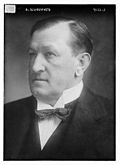Boundaries and History
This area had previously been represented as part of the South East Lancashire multi-seat division. The Redistribution of Seats Act 1885 divided the former constituency into eight new single-member seats, one of which was designated South-East Lancashire, Heywood Division. [4]
The constituency comprised the Municipal Borough of Heywood, the cotton town of Ramsbottom, and a number of surrounding townships, namely: Ainsworth, Ashworth, Pilkington, Tottington Higher End and the rural part of the parish of Spotland. [5]
The constituency was mostly industrial but it included some agriculture. The town of Heywood was the most Liberal part of the constituency, having an engineering-based economy; Ramsbottom was more marginal politically. The countryside element of the constituency was Conservative inclined. Overall the division was Liberal 1885–1895, Liberal Unionist 1895–1904 and after a change of allegiance by the sitting MP was Liberal again from 1904 until the constituency was abolished in 1918.
The constituency adjoined Westhoughton to the west, Rossendale to the north, Middleton and Rochdale to the east as well as Radcliffe-cum-Farnworth, Bury, and another part of the Middleton constituency to the south.
The Representation of the People Act 1918 abolished this constituency. The successor seat was Heywood and Radcliffe.
This page is based on this
Wikipedia article Text is available under the
CC BY-SA 4.0 license; additional terms may apply.
Images, videos and audio are available under their respective licenses.





